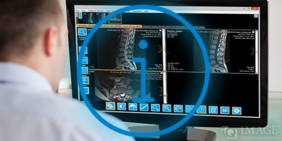WADO: Different ways to access DICOM objects over the web
Learn about the different ways to access DICOM objects and how WADO can be used to share images.
The times when medical images were distributed by means of CDs/DVDs are on their way out. Being able to quickly and securely access and share medical images and reports over the web helps save a lot of time and resources in the healthcare arena. The WADO standard was established to provide a proper framework for the Web Access to DICOM Objects. Find out below which WADO options exist and how they work.
Which WADO options are there?
There are several ways to provide web access to DICOM objects, depending on the specific use case and requirements. Here are some possible options:
- 1. DICOMweb:
DICOMweb is a RESTful web API that provides access to DICOM objects over the web using standard HTTP(S) protocols. DICOMweb supports a range of DICOM services, including query, retrieve, store, and send. It is becoming an increasingly popular way to provide web-based access to DICOM data. Only a few applications support DICOM web. There is no application-to-user interaction possible, only application-to-application, but this is a good standard between web applications. - 2. Web-based DICOM viewers:
There are several web-based DICOM viewers available that can display DICOM images directly in a web browser. These viewers typically use HTML5 and JavaScript to render the images and provide tools for zooming, panning, and adjusting image settings. Examples of web-based DICOM viewers include Cornerstone.js, OHIF Viewer, and Orthanc Web Viewer. Many of these can be opened over the web, but few have comprehensive URL logic and even fewer offer full web authentication and URL logic, such as iQ-4VIEW or iQ-FUSION. - 3. Cloud-based DICOM services:
There are also cloud-based DICOM services that provide web-based access to DICOM objects stored in the cloud. These services can include features such as image processing, analysis, and sharing, as well as secure storage and access controls. Examples of cloud-based DICOM services include Ambra Health, AWS Medical Imaging, Google Cloud Healthcare API, and iQ-4CLOUD. iQ-4CLOUD offers much of the same functionality as iQ-WEB, but is hosted entirely in the cloud with a pay-per-use model. - 4. Custom web applications:
Another way to provide access to DICOM objects is to develop custom web applications tailored to specific use cases and requirements. These applications can be built using web frameworks such as Flask, Django, or Ruby on Rails, and can use DICOM libraries such as pydicom or dcmtk to manipulate DICOM data. However, these are not entirely standard-based and should not be considered.
-------------------------------------------------------------
How can WADO be used to share images from a PACS for human interaction?
The overall purpose of WADO is to rapidly and securely share patient studies e.g. with referring physicians, treating physicians or patients. Here are some of the most frequently asked questions regarding this topic:
- 1. How can the patient typically be identified using WADO?
AccNo Share a single study or a few studies using the accession number usually entered during acquisition StudyUID Share a single study using the DICOM study UID PID Share all cases of a patient using the Patient ID oPID Share all cases of a patient using the Other Patient Identification which is typically a master PID (usually from local and other imaging centers using the oPID as an identifier) - 2. How do users get access to data?
a) Recipient receives an email with a WADO link and opens it, or
b) Recipient receives a printed or copied QR code or a message using WhatsApp messenger or similar ways
c) Such WADO URLs can also be inserted into HIS/RIS/practice management systems to automatically open studies from there. - 3. How does the authentication work?
a) User must be registered in the user database of iQ-WEB or iQ-4CLOUD
b) User must login via LDAP from an enterprise/campus user domain
c) No user login required, e.g. for veterinary
d) Patient DOB authentication, e.g. patient or physician receives a link and must enter the DOB to get access to data - 4. How about the data quality?
Most web viewers are non-diagnostic, but iQ-FUSION and iQ-4VIEW provide a full diagnostic image resolution when opened on a diagnostic monitor. - 5. How can I import data received via WADO into my PACS?
Some vendors only share a download link to DICOM objects while iQ-SYSTEM PACS and iQ-4CLOUD display the study(ies) first. Users can simply download data to a local DICOM viewer or PACS if the WADO sender has assigned sufficient user rights.
In summary, there are several options to provide web access to DICOM objects, ranging from standard APIs like DICOMweb to web applications incl. non-diagnostic or diagnostic viewers. The choice of approach depends on the specific use case and requirements. WADO is the key for efficient information exchange in modern healthcare until global and completely central VNA/PACS become fully available.
